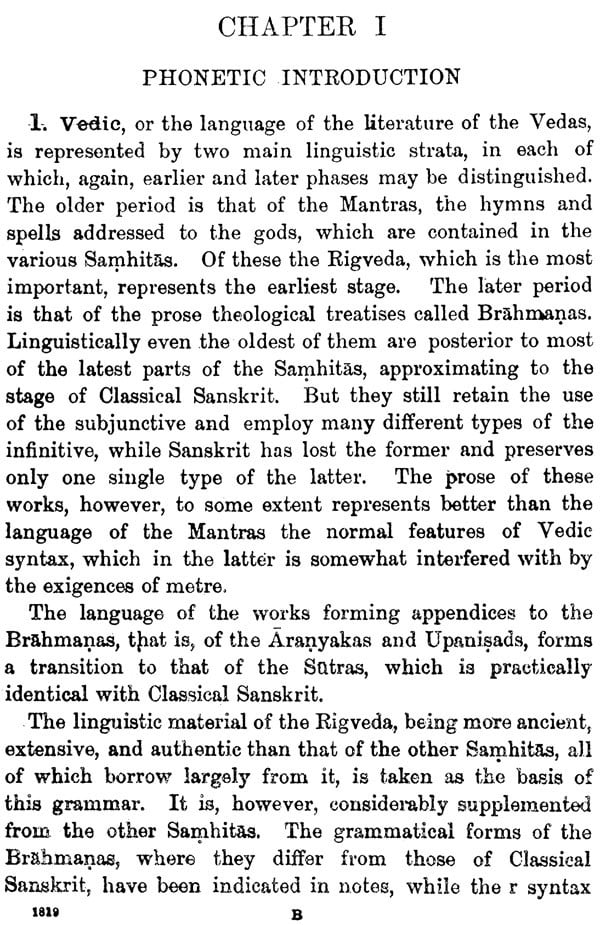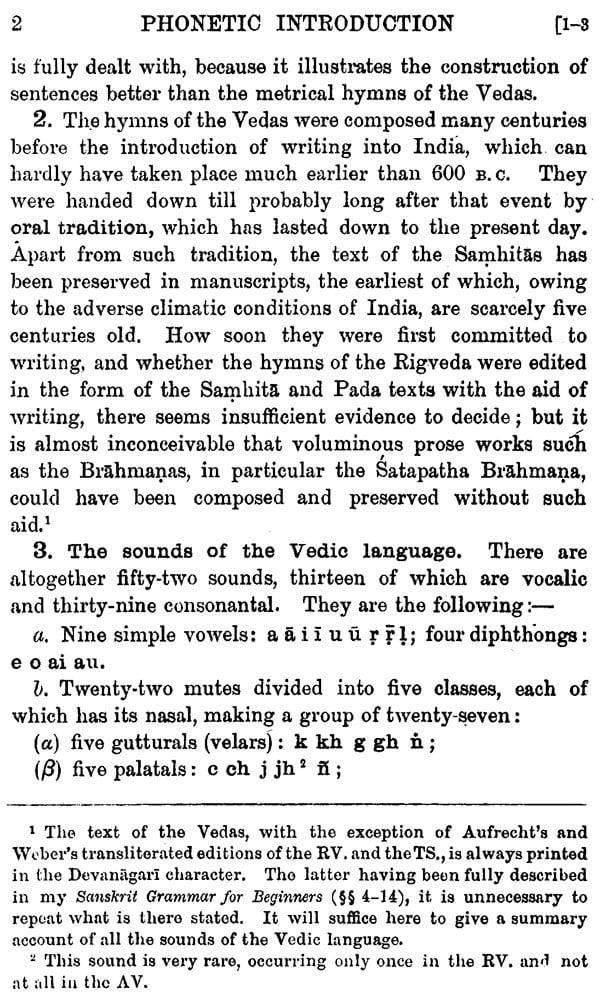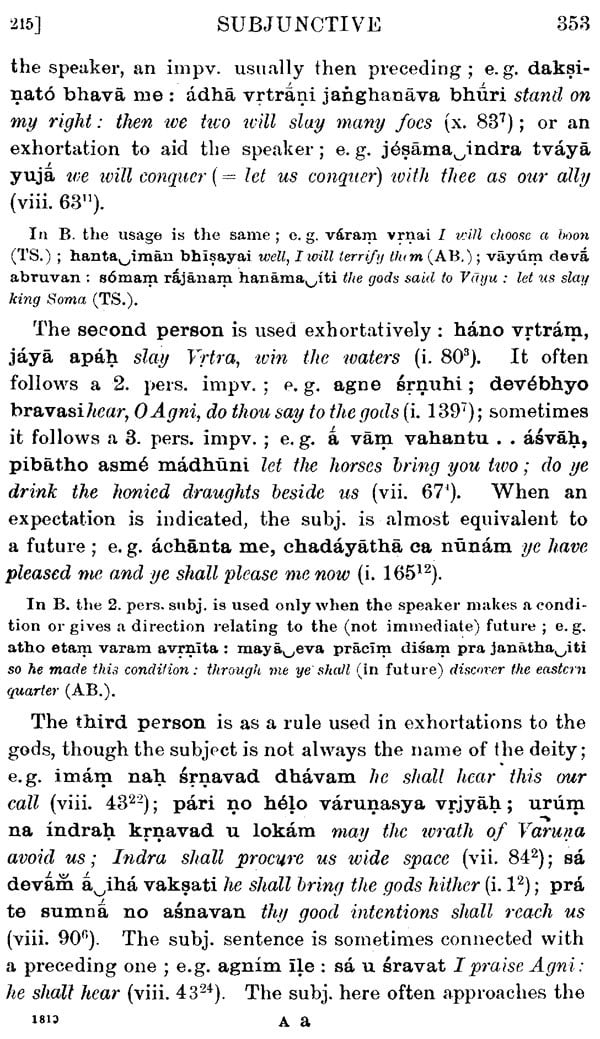
A Vedic Grammar for Students
Book Specification
| Item Code: | IDD439 |
| Author: | Arthur A. Macdonell |
| Publisher: | MOTILAL BANARSIDASS PUBLISHERS PVT. LTD. |
| Language: | English |
| Edition: | 2000 |
| ISBN: | 9788120810525 |
| Pages: | 520 |
| Cover: | Hardcover |
| Other Details | 7 |
Book Description
The present work is to a great extent based on the author's larger Vedic Grammar. It is, however, by no means simply an abridgement of that work. For besides being differently arranged so as to agree with the scheme of his another work Sanskrit Grammar it contains much matter excluded from the Vedic Grammar: It, for example, adds a fully treatment of Vedic Syntax and an account of the Vedic Metres. Thus it constitutes a supplement as well as an abridgement of the Vedic Grammar.
The Term 'Vedic' is here used to comprehend not only the metrical language of the hymns, but also the prose of the Brahmanas and of the Brahmana-like portions of the Atharvaveda and of various recensions of the Yajurveda.
A practical Vedic grammar has long been a desideratum. It is one of the chief aids to the study of the hymns of the Veda called for forty three years ago in the preface to his edition of the Rigveda by Max Muller, who adds, ‘I doubt not that the time will come when no one in India will call himself a Sanskrit scholar who cannot construe the hymns of the ancient Rishis of his country ’. It is mainly due to the lack of such a work that the study of Vedic literature, despite its great linguistic and religious importance, has never taken its proper place by the side of the study of Classical Sanskrit either in England or India. Whitney’s excellent Sanskrit Grammar, indeed, treats the earlier language in its historical connexion with the later, but for this very reason students are, as I have often been assured, unable to acquire from it a clear knowledge of either the one or the other, because beginners cannot keep the two dialects apart in the process of learning. Till the publication of my large Vedic Grammar in 1910, no single work comprehensively presented the early language by itself. That work is, however, too extensive and detailed for the needs of the student, being intended rather as a book of reference for the scholar. Hence I have often been urged to bring out a short practical grammar which would do for the Vedic language what my Sanskrit Grammar for Beginners does for the Classical language. In the second edition (1911) of the latter work I therefore pledged myself to meet this demand as soon as I could. The present volume redeems that pledge.
When planning the book I resolved, after much reflection, to make it correspond paragraph by paragraph to the Sanskrit Grammar, this being the best way to enable students to compare and contrast every phenomenon of the earlier and the late language. To this extent the present book presupposes the other; but it can quite well be used independently. The experience of many years’ teaching, however, leads me to dissuade beginners from starting the study of Sanskrit by means of the present grammar. Students should, in my opinion, always commence with classical Sanskrit, which is more regular and definite, as well as much more restricted in the number of its in flexional forms. A good working knowledge of the later language should therefore be acquired before taking up Vedic grammar, which can then be rapidly learned.
In carrying out the parallelism of this grammar with the other I have experienced a good deal of difficulty in numbering the corresponding paragraphs satisfactorily, because certain groups of matter are found exclusively in the Vedic language, as the nume1•ous subjunctive forms, or much more fully, as the dozen types of infinitive compared with only in Sanskrit; while some Sanskrit formations, as the periphrastic future, are non-existent in the earlie1• language. Nevertheless, I have, I think, succeeded in arranging the figures in such a way that the corresponding paragraphs of the two grammars can always be easily compared. The only exception is the first chapter, consisting of fifteen paragraphs, which in the Sanskrit Grammar deals with the Nagar! alphabet. As the present work throughout uses transliteration only, it seemed superfluous to repeat the description of the letters given in the earlier work. I have accordingly substituted a general phonetic survey of Vedic sounds as enabling the student to understand clearly the linguistic history of Sanskrit. The employment of transliteration has been necessary because by this means alone could analysis by hyphens and accentuation be adequately indicated. Duplication with Nagari characters, as in the Sanskrit Grammar, would have increased the size and the cost of the book without any compensating advantage. An account of the accent, as of vital importance in Vedic grammar, would naturally-have found a place in the body of the book, but owing to the entire absence of this subject in the Sanskrit Grammar and to the fulness which its treatment requires, its introduction there was impossible. The accent is accordingly dealt with in Appendix III as a substitute for the ‘Chief Peculiarities of Vedic Grammar’ appearing at the end of the Sanskrit Grammar.
The term Vedic is here used to comprehend not only the metrical language of the hymns, but also the prose of the Brahmanas and of the Biahmana-like portions of the Atharvaveda and of various recessions of the Yajurveda. The grammatical material from the later period is mainly given in small type, and is in any case regularly indicated by the addition of the letter B (for Brahmana). Otherwise the phase of the earlier language presented is that of the Rigveda, as being both the oldest and furnishing the most abundant material. But forms from the other Vedas are often also supplied without any distinguishing mark as long as they conform to the standard of the Rigveda. If, how- eve1•, such forms are in any way abnormal, or if it seemed advisable to point out that they do not come from the Rigveda, this is indicated by an added abbreviation in brackets, as ‘(AV.) ’ for ‘(Atharvaveda).’ On the other hand ‘(RV.)’ is sometimes added in order to indicate, for some reason or other, that a form is restricted to the Rigveda. It is, of course, impossible to go much into detail thus in a practical work; but the exact source of any particular form can always be ascertained by reference to the large Vedic Grammar. The grammatical usage of the other Vedas, when it differs from that of the Rigveda, is regularly explained. The reference is given with precise figures when syntactical examples are taken from the Rigveda, but with abbreviations only (as TS. for Taittiriya Samhita or SB. for Satapatha Brahmana) when they come from elsewhere. Syntactical citations are not always metrically intact because words that are unnecessary to illustrate the usage in question are often omitted. The accent in verbal forms that happen to occur in Vedic texts without it, is nevertheless given if its position is undoubted, but when there is any uncertainty it is left out. In the list of verbs (Appendix I) the third person singular is often given as the typical form even when only othe1• persons actually occur. Otherwise only forms that have been positively noted are enumerated.
I ought to mention that in inflected words final s, r, and d of endings are given in their historical form, not according to the law of allowable finals ( 27) ; e. g. dutas, not dutah; tasmad, not tasmat; pitur, not pituh; but when used syntactically they appear in accordance with the rules of Sandhi; e. g. devanam dutah; vrtrasya vadhat.
The present` book is to a great extent based on my large Vedic Grammar. It is, however, by no means simply an abridgement of that work. For besides being differently arranged, so as to agree with the scheme of the Sanskrit Grammar, it contains much matter excluded from the Vedic Grammar by the limitations imposed on the latter work as one of the volumes of Buhler’s Encyclopaedia of Indo-Aryan Research. Thus it adds a full treatment of Vedic Syntax and an account of the Vedic metres. Appendix I, moreover, contains a list of Vedic verbs (similar to that in the Sanskrit Grammar), which though all their forms appear in their appropriate place within the body of the Vedic Grammar, are not again presented there in the fo1•m of an alphabetical list_ as is done here for the benefit of the learner; Having subjected all the ve1•bal forms to a revision, I have classified some doubt full or ambiguous ones more satisfactorily, and added some others which were inadvertently omitted in the large work. Moreover, a full alphabetical list of conjunctive and adverbial particles embracing forty pages and describing the syntactical uses of these words has been added in order to correspond to § 180 of the Sanskrit Grammar. The present work therefore constitutes a supplement to, as well as an abridgement of, the Vedic Grammar, thus in reality setting forth the subject with more completeness as a whole, though in a comparatively brief form, than the larger Work. I may add that this grammar is shortly to be followed by a Vedic Reader consisting of selected hymns of the Rigveda and supplying microscopic explanations of every point on which the elementary learner requires information. These two books will, I hope, enable him in a short time to become an independent student of the sacred literature of ancient India.
For the purposes of this book I have chiefly exploited my own Vedic Grammar (1910), but I have also utilized Delbruck’s Altindische Syntax (1888) for syntactical material, and Wl1itney’s Roots (1885) for the verbal forms of the Brahmana literature. In describing the metres (Appendix II) I have found Oldenberg’s Die Hymnen des Rigveda (1888), and Arnold’s Vedic Metre (1905) very useful.
I am indebted to Dr. James Morison and to my former pupil, Professor A. B. Keith, for reading all the first proofs with great care, and thus saving me from many misprints that would have escaped my own notice. Professor Keith has also suggested important modifications of some of my grammatical statements. Lastly, I must congratulate Mr. J.C. Pembrey, Hon. M.A., Oriental Reader at the Clarendon Press, on having completed the task of reading the final proofs of this grammar, now al but seventy years after correcting Professor H.H. Wilson’s Sanskrit Grammar in 1847. This is a record in the history of Oriental, and most probably of any, professional proof reading for the press.
| Preface | v-x |
| List of Abbreviations | xiii |
|
|
|
| Relation of Vedic to Sanskrit - Oral tradition and writing - Sounds of the Vedic Language - The Vowels - Vowel Gradation - The Consonants - Ancient Pronunciation | 1-19 |
|
|
|
| External Sandhi: Combination of Vowels and of Consonants - Internal Sandhi: Combination of Vowels and of Consonants | 20-47 |
|
|
|
| Nouns: Consonant Stems - unchangeable - changeable: with Two Stems; with Three stems - Vowel Stems - Degrees of Comparison - Numerals: Cardinals; Ordinals; Numeral Derivatives - Pronouns: Personal - Demonstrative - Interrogative - Relative - Reflexive - Possessive - Compound - Derivative - Indefinite - Pronominal Adjectives | 47-117 |
|
|
|
| Introductory - The Present System - First Conjugation - Second Conjugation - The Augment - Reduplication - Terminations - Paradigms - Irregularities - The Perfect - The Pluperfect - The Aorist: First Aorist; Second Aorist - Benedictive - The Future: Simple; Periphrastic - Conditional - The Passive - Participles - Gerund - Infinite - Derivative Verbs: Causative - Desiderative - Intensive - Denominative | 117-207 |
|
|
|
| Preposition - Adverbial Case - forms - Adverbs formed with Suffixes - Conjunctive and Adverbial Particles - Interjections | 208-253 |
|
|
|
| Primary Suffixes - Secondary Suffixes - Gender - Verbal Compounds - Nominal Compounds: Co-ordinatives - Determinatives: Dependent and Descriptive - Possessives - Governing Compounds - Syntactical Compounds - Iterative Compounds | 254-282 |
|
|
|
| Introductory - Order of Words - Number - Concord - Pronouns - Use of the Cases - Locative and Genitive Absolute - Participles - Gerund - Infinitive - Use of the Tenses - Use of the Moods: Imperative - Injunctive - Subjunctive - Optative - Precative - Conditional | 283-368 |
| Appendix I List of verbs | 369-435 |
| Appendix II Vedic Metre | 436-447 |
| Appendix III The Vedic Accent | 448-469 |
| Vedic Index | 471-498 |
| General Index | 499-508 |
| Corrections | 509 |













